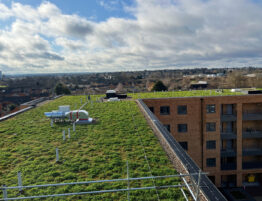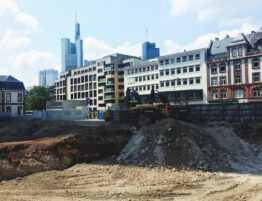
While the generally drier weather of summer makes it one of the best times for completing construction works, every year the season also brings some additional challenges, for instance around maintaining the quality of products, the reduced availability of workers and specific heat-related safety risks.
Four areas of concern to watch out for include:
1. Dust control and airborne particles
Dust control measures are a vital part of any construction site’s operation procedures but this requires even closer attention during summer. This is when the combination of dry conditions and the use of tools/plant machinery can create more airborne dust and any wind could cause it to blow onto neighbouring properties. Taking measures to prevent or reduce the impact of this is the number one priority but where that’s not possible, the two main ways to control dust involve using water to dampen it down or using on-tool extraction systems. Read the HSE guidance on this issue here.
2. Combustible materials and fire hazards
With our summers apparently getting hotter, there is an increased risk of fires on site. The danger could either come from wild fires which spread into populated areas or those which start on site due to the use/ storage of combustible materials. To avoid accidental fires, it’s crucial that all combustible materials are tightly controlled, keeping their storage to a minimum and making sure there are not kept close to any ignitable substances (e.g. fuel or flammable packaging nearby waste materials). For more details read our fire safety blog here.
3. Tired or distracted workers
The combination of longer days, warmer weather and kids out from school means many construction workers might be doing way more outside of work than they would during the more sedentary winter months. They may stay up later, socialise more, consume more alcohol, take more day trips and/or try to fit other more active pursuits into their evenings. On top of this, they may try to skip breaks during working hours so as to leave earlier and spend more time with friends or family. All of this can lead to workers being distracted, fatigued or exhausted, increasing the potential for accidents. Tactics to deal with this include enforcing adequate break periods and taking a short period of time each morning to assess employee health. Asking workers to complete a few stretch exercises is a good way of doing this. For example, if an employee is unable to stand on one leg it may be a sign of weakened health.
4. Heat risks, injuries and other health concerns
When temperatures rise, workers can be exposed to several associated health risks – burns from materials that overheat in the sun, sunburn, heat stress, heat stroke, dehydration and even bee/wasp stings from stumbling across an unexpected nest in roofing, pallets or underground.
To avoid such problems, workers should wear gloves when handling items that have been left in direct sunlight (particularly any metal objects). Sites should be equipped with plentiful water stations and workers should be encouraged to takes their rest periods in shaded areas while drinking lots of water (avoiding caffeinated or energy drinks). Read more about keeping safe in hot weather in our blog from last year, Hotter and Hotter.
Site First Aid kits should also include treatment options for minor stings and anyone with a bee allergy should carry their epi-pen with them on site and inform work colleagues of the allergy in order for them to quickly help if needed.
Of course, this year brings several more challenges which have arisen as a result of the pandemic and Brexit, most notably labour and materials shortages so we’ll come back to those in a future blog. Meanwhile, keep these four typical summer challenges in mind to stay free of injury and other health concerns.
03.08.2021
Feature image: Freepik








